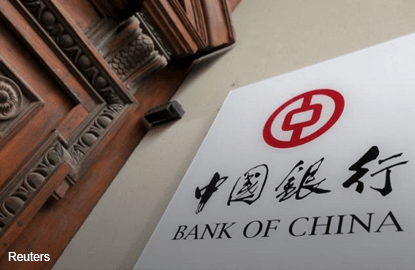
KUALA LUMPUR: Even before Prime Minister Datuk Seri Najib Razak set foot in China for his one-week visit late last month — a trip that saw a record RM144 billion of deals sealed among companies in the two countries — the Bank of China Ltd, one of the five biggest state-owned commercial banks in China, has already put in motion plans to build a regional Asean bank, with Malaysia as its hub.
On Oct 17, the Hong Kong-listed BOC Hong Kong (Holdings) Ltd announced it had completed the acquisition of the Bank of China (M) Bhd (BoC Malaysia) from its parent, the Bank of China.
“The acquisition will see BoC Malaysia become a subsidiary of Bank of China HK Ltd (BoCHK). This is the start of a change in strategy to transform BoCHK into a regional bank from a local bank serving just the city [of Hong Kong],” BoCHK chief operating officer Zhong Xiangqun said in a recent language-exclusive interview with local media.
BoCHK’s asset acquisition in six Asean countries from its parent, Bank of China, is part of the Bank of China Group’s strategy to build a “financial artery” in support of the national “One Belt, One Road” — also known as the Belt and Road (BnR) — initiative.
It announced the acquisition in June, which resulted in it taking over its parent’s branch and sub-branch network in Malaysia, Thailand, Indonesia, Cambodia, Vietnam and the Philippines. BoC Malaysia is the first Asean unit of the Bank of China Group that was merged into BoCHK.
“We look forward to serving the main customers [from China] that are related to the infrastructure projects in Malaysia. In fact, we are already serving some of them. At the same time, we would want to facilitate Malaysian corporations in their ventures into Asean countries,” Zhong said, adding that the bank’s strategy is in line with the Chinese government’s “One Belt, One Road” initiative.
The BnR blueprint aims to develop two corridors linking China to the world — the traditional land-based Silk Road Economic Belt and the 21st Century Maritime Silk Road — to boost the flow of trade, capital and services between China and the rest of the world.
A regional management approach to BoC Malaysia and other Asean institutions will be adopted to enhance the banking group’s overall business strength and market competitiveness in the Asean region, according to Zhong.
He said more resources will be put into BoC Malaysia, which saw its profit before tax rise 39.07% to RM34.85 million in the second quarter ended June 30, 2016, from RM25.06 million a year ago.
As to whether there would be acquisitions or collaborations with local banks as BoC Malaysia expands its footprint here, he just said it depends on “clients’ needs”.
BoC Malaysia currently has branches in Sarawak (Kuching), Johor (Muar, Johor Baru), Kuala Lumpur, Selangor (Klang, Puchong) and Penang. The bank is expected to open a new branch in Melaka soon, where China will be investing US$10 billion (RM43 billion) in the Malacca Gateway project, the largest private marina in Southeast Asia that will feature commercial and residential components, as well as the biggest seaport in the region, upon completion in 2025.
BoC Malaysia’s total assets improved by RM575.7 million to RM9 billion as at June 30, 2016. Loans and advances grew RM136.5 million to RM4.8 billion. Customer deposits in the first half ended June 30, 2016 (1HFY16) grew a moderate 2% to RM6.2 billion from 1HFY15.
BoC Malaysia’s focus now is to evolve into a mainstream bank in Malaysia. The integration and standardisation of processes/systems between BoCHK and its Malaysian subsidiary have commenced.
The mainstream aspiration will see BoC Malaysia tap segments like wealth management, fund management, private banking and credit cards, among others, said Zhong. At the same time, BoCHK will use its overseas network to extend its influence in Asean.
“We will do it step by step, bringing in products and services from Hong Kong, one of the most important financial centres in the world,” said BoC Malaysia chief executive officer Wang Hongwei. BoC Malaysia’s capital will be eventually doubled to US$600 million.
Its overall loan portfolio now comprises 70% Malaysians. Of that, half are small and medium entities.
BoC Malaysia, which was appointed by Bank Negara Malaysia as a yuan clearing bank in January 2015, also eyes opportunities from the growing use of yuan in Asean, as trades between China and Malaysia, as well as between China and other Asean countries, rise, especially given the growing role China plays as a financier and constructor of mega infrastructure works in the region.
Besides its strong trade relationship with China — last year, Chinese investment in Malaysia grew an annual 237% to a record high of US$400 million — Zhong said Malaysia’s ease of doing business, strategic geographical location and stable governance, also make it an attractive location to many Chinese businesses.
The commonwealth country also stands out with its population of Chinese diaspora, and its pole position in Islamic financing, when compared with other Asean countries. “There are Chinese in other Asean countries too, but Malaysian Chinese businessmen are the most influential ones,” he said.
Bank of China established its first branch in Malaysia in 1939, but ceased operations in 1959. Following rapid economic and trade development between Malaysia and China in the subsequent years, BoC Malaysia recommenced business as a commercial bank on Feb 23, 2001. It currently employs about 300 people.